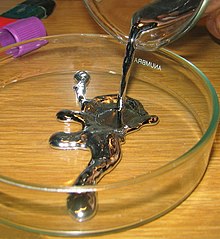See also Template:Infobox unbinilium/testcases E120 Chemical element with atomic number 80 (Hg)
Mercury, 80 Hg Appearance shiny, silvery liquid
Atomic number (Z ) 80 Group group 12 Period period 6 Block d-block Electron configuration [Xe ] 4f14 5d10 6s2 Electrons per shell 2, 8, 18, 32, 18, 2 Phase at STP liquid Melting point 234.3210 K (−38.8290 °C, −37.8922 °F) Boiling point 629.88 K (356.73 °C, 674.11 °F) Density (near r.t. ) 13.546 g/cm3 [ 3] Triple point 234.3156 K, 1.65 × 10−7 kPa Critical point 1750 K, 172.00 MPa Heat of fusion 2.29 kJ/mol Heat of vaporization 59.11 kJ/mol Molar heat capacity 27.983 J/(mol·K) Vapor pressure
P (Pa)
1
10
100
1 k
10 k
100 k
at T (K)
315
350
393
449
523
629
Oxidation states common: +1, +2 [ 4] Electronegativity Pauling scale: 2.00 Ionization energies 1st: 1007.1 kJ/mol 2nd: 1810 kJ/mol 3rd: 3300 kJ/mol Atomic radius empirical: 151 pm Covalent radius 132±5 pm Van der Waals radius 155 pm Spectral lines of mercuryNatural occurrence primordial Crystal structure rhombohedral (hR1 ) Lattice constants a r = 301.06 pma h = 347.64 pmc h = 673.20 pm (at triple point)[ 5] Thermal expansion 60.4 µm/(m⋅K) (at 25 °C) Thermal conductivity 8.30 W/(m⋅K) Electrical resistivity 961 nΩ⋅m (at 25 °C) Magnetic ordering diamagnetic[ 6] Molar magnetic susceptibility × 10−6 3 /mol (293 K)[ 7] Speed of sound liquid: 1451.4 m/s (at 20 °C) CAS Number 7439-97-6 Discovery Ancient Egyptians (before 1500 BCE) Symbol "Hg": from its Latin name hydrargyrum hydrárgyros
Category: Mercury (element) references
Chemical element with atomic number 80 (Hg)
Mercury, 80 Hg Appearance shiny, silvery liquid
Atomic number (Z ) 80 Group group 12 Period period 6 Block d-block Electron configuration [Xe ] 4f14 5d10 6s2 Electrons per shell 2, 8, 18, 32, 18, 2 Phase at STP liquid Melting point 234.3210 K (−38.8290 °C, −37.8922 °F) Boiling point 629.88 K (356.73 °C, 674.11 °F) Density (near r.t. ) 13.546[ 10] 3 Triple point 234.3156 K, 1.65×10−7 kPa Critical point 1750 K, 172.00 MPa Heat of fusion 2.29 kJ/mol Heat of vaporization 59.11 kJ/mol Molar heat capacity 27.983 J/(mol·K) Vapor pressure
P (Pa)
1
10
100
1 k
10 k
100 k
at T (K)
315
350
393
449
523
629
Oxidation states common: +1, +2 [ 4] Electronegativity Pauling scale: 2.00 Ionization energies 1st: 1007.1 kJ/mol 2nd: 1810 kJ/mol 3rd: 3300 kJ/mol Atomic radius empirical: 151 pm Covalent radius 132±5 pm Van der Waals radius 155 pm Spectral lines of mercuryNatural occurrence primordial Crystal structure rhombohedral Thermal expansion 60.4 µm/(m⋅K) (at 25 °C) Thermal conductivity 8.30 W/(m⋅K) Electrical resistivity 961 nΩ⋅m (at 25 °C) Magnetic ordering diamagnetic[ 11] Molar magnetic susceptibility × 10−6 3 /mol (293 K)[ 12] Speed of sound liquid: 1451.4 m/s (at 20 °C) CAS Number 7439-97-6 Discovery Ancient Egyptians (before 1500 BCE ) Symbol "Hg": from its Latin name hydrargyrum hydrárgyros
Category: Mercury (element) references
^ "Standard Atomic Weights: Mercury" . CIAAW . 2011.^ a b Prohaska, Thomas; Irrgeher, Johanna; Benefield, Jacqueline; Böhlke, John K.; Chesson, Lesley A.; Coplen, Tyler B.; Ding, Tiping; Dunn, Philip J. H.; Gröning, Manfred; Holden, Norman E.; Meijer, Harro A. J. (2022-05-04). "Standard atomic weights of the elements 2021 (IUPAC Technical Report)" . Pure and Applied Chemistry . doi :10.1515/pac-2019-0603 . ISSN 1365-3075 . ^ Fehlauer, H.; Bettin, H. (2004). "Density of mercury—measurements and reference values" . Metrologia . 41 (2): S16–S22. doi :10.1088/0026-1394/41/2/S02 . Retrieved 2023-07-08 . ^ a b Brauer, G.; Haucke, W. (1936-06-01). "Kristallstruktur der intermetallischen Phasen MgAu und MgHg" . Zeitschrift für Physikalische Chemie . 33B (1): 304–310. doi :10.1515/zpch-1936-3327 . ISSN 2196-7156 . MgHg then lends itself to an oxidation state of +2 for Mg and -2 for Hg because it consists entirely of these polar bonds with no evidence of electron unpairing. (translated) ^ Arblaster, John W. (2018). Selected Values of the Crystallographic Properties of Elements . Materials Park, Ohio: ASM International. ISBN 978-1-62708-155-9 ^ "Magnetic Susceptibility of the Elements And Inorganic Compounds" (PDF) . www-d0.fnal.gov . Fermi National Accelerator Laboratory: DØ Experiment (lagacy document). Archived from the original (PDF) on 2004-03-24. Retrieved 18 February 2015 .^ Weast, Robert (1984). CRC, Handbook of Chemistry and Physics . Boca Raton, Florida: Chemical Rubber Company Publishing. pp. E110. ISBN 0-8493-0464-4 ^ a b Kondev, F. G.; Wang, M.; Huang, W. J.; Naimi, S.; Audi, G. (2021). "The NUBASE2020 evaluation of nuclear properties" (PDF) . Chinese Physics C . 45 (3): 030001. doi :10.1088/1674-1137/abddae . ^ "Standard Atomic Weights: Mercury" . CIAAW . 2011.^ Fehlauer, H.; Bettin, H. (2004). "Density of mercury—measurements and reference values" . Metrologia . 41 (2): S16–S22. doi :10.1088/0026-1394/41/2/S02 . Retrieved 2023-07-08 . ^ "Magnetic Susceptibility of the Elements And Inorganic Compounds" (PDF) . www-d0.fnal.gov . Fermi National Accelerator Laboratory: DØ Experiment (lagacy document). Archived from the original (PDF) on 2004-03-24. Retrieved 18 February 2015 .^ Weast, Robert (1984). CRC, Handbook of Chemistry and Physics . Boca Raton, Florida: Chemical Rubber Company Publishing. pp. E110. ISBN 0-8493-0464-4 


